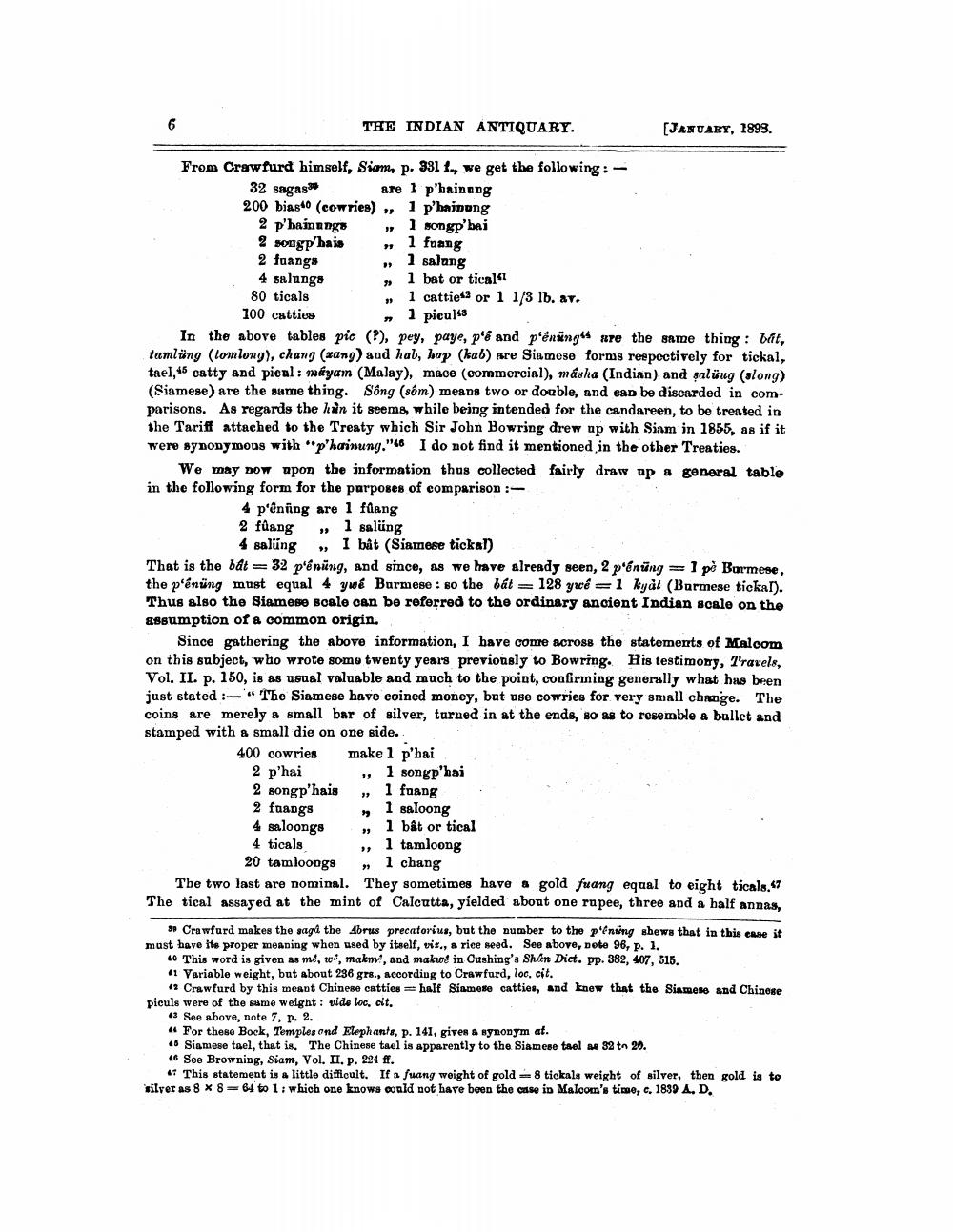________________
THE INDIAN ANTIQUARY.
[JANUARY, 1893.
From Crawfurd himself, Siam, p. 331 1., we get the following:
32 sagassa are 1 phaineng 200 bias 0 (cowries), 1 phaidung 2 p'hain ang
» 1 songp'bai 2 songp'hais - 1 fuang 2 faangs . 1 salang 4 salungs
1 bat or tical 80 ticals
► 1 cattiesor 1 1/3 lb. av. 100 catties
– 1 pieal43 In the above tables pic (?), pey, paye, p'e and péningts are the same thing: bát, tamling (tomlong), chang (wang) and hab, hap (kab) are Siamese forms reepoctively for tickal, tael,45 catty and picul: meyam (Malay), mace (commercial), masha (Indian) and galuug (slong) (Siamese) are the sume thing. Sông (sôm) means two or double, and can be discarded in comparisons. As regards the han it seems, while being intended for the candareen, to be treated in the Tariff attached to the Treaty which Sir John Bowring drew up with Sinm in 1855, as if it were synonymous with 'p'harinung."46 I do not find it mentioned in the other Treaties.
We may now apon the information thus collected fairly draw ap a general table in the following form for the parposes of comparison :
4 péning are 1 fuang 2 fúang 1 saling
4 salung , I båt (Siamese tickal) That is the bt=32 pénung, and since, as we have already seen, 2 p'énung = 1 pě Barmese, the p'éning must equal 4 ywé Burmese : so the bát = 128 ywé = 1 kyal (Barmese tickal). Thus also the Siamese scale can be referred to the ordinary ancient Indian scale on the assumption of a common origin.
Since gathering the above information, I have come across the statements of Malcom on this subject, who wrote some twenty years previonsly to Bowring. His testimony, Travels, Vol. II. p. 150, is as usual valuable and much to the point, confirming generally what has been just stated :- "The Siamese have coined money, but use cowries for very small change. The coins are merely a small bar of silver, turned in at the ends, so as to resemble a bullet and stamped with a small die on one side.
400 cowries make 1 p'bai
2 p'hai - 1 songphai 2 songp'hais , 1 fueng 2 faangs
1 saloong 4 saloongs » 1 båt or tical 4 ticals
1 tamloong 20 tam loongs 1 chang The two last are nominal. They sometimes have a gold fuang equal to eight ticals.97 The tical assayed at the mint of Calcutta, yielded about one rapee, three and a half annas,
Crawfurd makes the saga the Abrus precatorius, but the number to the pening shews that in this case it must have its proper meaning when used by itself, viz., a rice seed. See above, note 96, p. I.
40 This word is given as me, 20", makm?, and makuod in Cushing's Shan Dict. pp. 382, 407, 516. 41 Variable weight, but about 236 grs., according to Crawfurd, loc. cit.
42 Crawfurd by this meant Chinese catties half Siamese catties, and knew that the Siamese and Chinese piculs were of the same weight : vide loc. cit. 13 See above, note 7, p. 2.
For these Bock, Temples and Elephants, p. 141, gives a synonym at. « Siamese tael, that is. The Chinese tael is apparently to the Siamese tael se 32 tn 20. 16 See Browning, Siam, Vol. II. p. 224 ff.
17 This statement is a little difficult. If a fuang weight of gold = 8 tickals weight of silver, then gold is to silver as 8 x 8=64 to 1:which one knows would not have been the case in Maloom's time, c. 1839 4. D.




